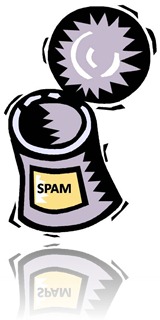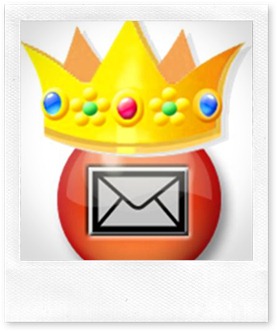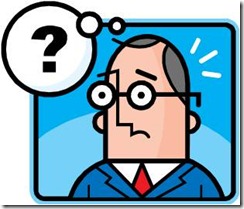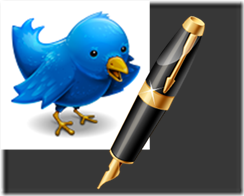Entries Tagged 'copywriting tips' ↓
May 5th, 2010 — copywriter, copywriting tips, email marketing, freelance copywriter

There are three things every email marketer wants to achieve:
- They want their message to be delivered
- They want to establish a relationship of trust with their mailing list
- They want their emails to be read
But, if you want to become known as an email spammer that won’t be important to you. You won’t care about your recipient. You’ll go out of your way to send annoying emails. You will want them to unsubscribe from or block your messages.
To help you become a spammer extraordinaire, just follow these tips:
1. Never use a real name
Don’t you just hate it when you get emails from real people? Wouldn’t it be better to conceal your true identity?
Who cares if your email shows it’s come from Sally Ormond or Briar Copywriting? It would be much better to use something like ‘Bulk’, ‘List’, ‘Blank’. The recipient will never guess it’s a spam email with a senders name like that.
2. Make sure your subject line rings alarm bells
Subject lines that make sense are so boring. It’s much better to use something nonsensical – Brodie tell freelancecopywriter.com – fab! That tells the reader absolutely nothing. Of course, if you really want to get their attention THERE’S NO BETTER WAY THAN USING CAPITAL LETTERS!!!
3. Don’t send it to real people
Do you really want to spend time making sure you have a real person’s name in your recipient’s email address? Of course not. Just sent them out to generic addresses. Yes, some might get stuck in spam filters but there’ll be some that get through.
4. Use catch phrases where possible
Why waste your time trying to come up with a strong subject line that is informative and eye catching? Go with the good old ‘free’, ‘cheap’, ‘GUARANTEED’, ‘no obligation’. It’s not as if your recipients are going to be bright enough to work out we only use those words to make them open our emails.
5. Don’t worry about the quality of your copy
People always bang on about making sure you proofread everything. What’s the harm in the odd spelling mistake, punctuation balls-up or grammatical error? They’ll be so busy they won’t even notice.
6. Don’t get cocky
If you’re confident in your writing you’ll make your reader think you know what you’re taking about.
Keep it vague. Use words like ‘I was wondering’, ‘perhaps you could’ – I mean, it’s not as if we want the reader to take action is it?
7. Send it to anyone
I’m not into all this sending information only to those who are interested. How do you know if someone is interested or not? I mean, it’s like those emails you get from SEO companies. It’s not like they’ve got time to check to see if the company they’re mailing out to is on the front page of Google or not is it? OK, so the copywriter we emailed was on the front page for the term ‘copywriter’ but I bet there are some terms they’re not on the front page for. That’s why it’s important to be vague in your email – specifics will only cause problems.
Why do you need to know this?
If you want to become known as a spammer, these 7 tips will help you.
But if you want to avoid that particular tag, remember:
- always use a real name in the sender field
- ensure your subject lines make sense, are informative and don’t use capital letters
- send your emails to a real address including a persons name
- avoid catch phrases and words like ‘free’ ‘cheap’ ‘GUARANTEED’
- make sure you proofread before sending out your email
- write with confidence, if you want your reader to take action, tell them
- make sure your email only goes to those who would be interested/or would benefit from your product/service
May 3rd, 2010 — copywriter, copywriting tips, email marketing, freelance copywriter

The advent of email marketing has revolutionised the way many businesses market themselves today.
Never before have you been able to market to so many people, so quickly and cheaply.
But as well as being one of the most efficient forms of marketing, it can also be one of the most damaging if you get it wrong.
How to get email marketing right
One of the most important aspects of email marketing is your list. Yes, you could take a short cut and go and buy yourself a mailing list, but will that really work?
By far the best mailing list you can have is your own in-house list. Yes, it will take time to build but its quality will be far superior to anything you can ‘buy off the shelf’.
Of course, to do this you have to get people to part with their email addresses which isn’t as easy as it sounds. You’ll have to offer them something worthwhile – great information, fantastic tips, special offers.
How to generate sign ups and keep them
I have put together 7 simple steps to help you get your email marketing right. Follow these and you’ll increase your sign ups and keep them subscribed.
1. Make is easy
If you want someone to sign up for your newsletter/email marketing, you have to make it easy for them.
Just ask for their email address – at this stage you don’t need anything else. Long forms asking for loads of information will not be attractive. Remember at this stage you’re not looking at generating leads, all you want is an email address so you can add value to your relationship with them.
Also, make sure you reassure them you won’t spam or pass on their details to a third party.
2. Sign them up
A visitor to your website isn’t going to hunt round it for your sign up box. So, you have to make sure your sign up box is prominent. You could place it on every page of your website, but why not also have it on your order form or even in your comments section.
That way, whenever they interact with you, you are giving them the opportunity to opt in to your mailing list.
3. Use a reliable service
There’s nothing worse than collecting loads of email addresses and then using a service that is going to constantly let you down.
You need one you can rely on to produce attractive and robust email/newsletter templates that are delivered first time, every time. I would recommend the Aweber service.
4. Work on your subject lines
Your subject line has to grab your recipient’s interest if you want them to open it. Don’t use anything spammy – go for things like ‘Tips’, ‘How to’, ‘Discover’, ‘Learn’.
If your company’s brand is well known, use it in your subject line so it is instantly recognisable as something to be read.
5. Make an impact
Most people, when they open your email, will just quickly scan the first few lines to see if it’s worth spending time on. So make sure your important information comes first.
Hit them hard and fast – grab their attention and draw them into the rest of your message.
6. Test
The best way to hone your email marketing skills is to split test. Divide your mailing in two and send out the same email but with two different subject lines.
Monitor which has the best open rate – learn what generates the best response and continually develop it. Over time you’ll begin to create powerful emails that really sell.
7. Make sure you give value
If you want people to subscribe and stay subscribed, you have to give them great information.
Sending them constant sales messages will just turn them off. You need to listen to them, give them information that will be of use to them. If your customer service team are fielding the same questions over and over again, use this in your marketing. Answer their questions and show them you listen.
If you get your email marketing right, you’ll develop strong and loyal relationships with your customers and boost your sales. You’ll become a name they know and trust. But it is all too easy to get it wrong.
Test, reliable services, great offers, valuable information – these are the things that will make your marketing work.
Sally Ormond – freelance copywriter
April 28th, 2010 — copywriter, copywriting tips, freelance copywriter

Whether you are talking about your sales website or your company blog, if your copy is lousy it’s going to let you down – big time.
Remember your school days? How the good looking kids always seemed to get an upper hand; you never saw an unattractive sports team captain, the head boy/girl was always gorgeous etc. Well, your website or blog is going to follow exactly the same trend.
Learn to be attractive
It pains me to have to admit that being attractive is the best way to get where you want to be. At school I was the ‘ever-so-slightly-heavier-than-she-should-be’ kid who was the last one to be picked during PE lessons. To try and lift me, my parents would come up with the old classic ‘looks aren’t everything’ – but the problem is, they are – at least to a certain extent.
To me, as a copywriter, the copy on your website or blog is paramount. It is that that does the hard work in engaging with your reader and getting them to place an order. But the look of your website or blog is going to have an effect of whether your reader actually stops to browse your site.
If you have an attractive looking site, that’s pleasing to the eye, someone is more likely to stick around and have a look. Of course, if the copy on that site is shocking, they’ll leave. Equally, if you have incredible copy on a God awful looking site, they’re not going to hang around long enough to read it.
Getting the picture?
There are many things you can do to make your website gorgeous, but rather than listing all of those, here are some things you should avoid at all costs:
Know who you are writing to. Your audience has specific needs – all you have to do is identify those and satisfy them.
Make sure you don’t try and talk to everyone. Have a single reader in mind when writing your copy. You can’t address everyone because if you try you’ll just end up creating copy that is confused.
Plus, when it comes to the length of your post, be sensible. Although your reader is going to want something that answers all their questions, they probably won’t have the time to sit and read your version of War and Peace. Make sure your copy is measured and complete but keep it relatively brief.
When you begin to write, think about how it looks. If your reader is faced with a wall of text that extends down their screen which the have to scroll through, they will be severely turned off.
Break your copy up into manageable chunks. Use sub headings to indicate what information is to follow so they can dip into your copy and read the most relevant parts to them.
Make it easy to read by using a high contrast between text colour and background – go for black on white or white on black. You don’t want your reader to have to strain to work out what you’ve written.
Before you even start thinking about the body of your copy you need to come up with a masterful headline that will grab your reader’s attention and make them want to read on.
If you produce dull copy, it won’t be read. Writing about how great you are or producing something that is stuffed with jargon, won’t get read. There is only one thing you have to keep in your mind – what does your reader want to know. To give you a clue it will probably have something to do with ‘What’s in it for me?’
At the end of the day, your reader will only spend their precious time reading your copy if they are going to get something out of it at. Harsh but true.
You will want to make your copy look appealing. But be careful with the colour. Splashing your page with a rainbow of colours will make it look gaudy rather than engaging. Stick with just a few colours that fit with your company’s image.
Also don’t over do the design elements on your site – less is definitely more. If you have too many pictures, logos, flashing images or banners on your site it will be distracting to your reader. Keep it simple.
Why do you need to know this?
Getting either your copy or your design wrong could effectively kill your site. You must make sure you consider both elements and how they need to work together.
If in doubt always go for less is more.
Sally Ormond – freelance copywriter
April 7th, 2010 — copywriter, copywriting tips, freelance copywriter

A big part of producing copy that sells is understanding what your reader wants to hear.
The problem is everyone is different. We all have different dreams, wants and goals, so how can you produce a piece of sales writing that is going to appeal to everyone?
You can’t please all of the people all of the time
You really can’t.
If you try to perform this particular miracle your writing will become confused and unfocused.
My elder son recently returned from a school French exchange trip. Before he left, he was busy practicing a few phrases. His great plan (and that of most of his class mates) was to come up with a conversation that would take place once they met their French families. It went something like this:
Robert: Bonjour
French family: Bonjour, avez-vous fait bon voyage?
Robert: Oui mercie. Êtes-vous bien?
French family: Oui, et vous?
Robert: Très bien, merci, mais je suis un peu fatigué
(Please excuse my French, it’s been a number of years since I studied the language.)
In his mind this was perfect; it would work like a dream and get his exchange trip off to a flying start.
Sadly, I did have to point out that, although it was a great idea to be thinking along the lines of what he was going to say to the family, as being as no one has told them of this cunning plan, the likelihood of the conversation panning out like that was remote.
As predicted, after practicing said conversation with his friends prior to arriving in Arras, once they got off the coach and met their families, one of two things happened: they either totally forgot what they were going to say, or the family threw in a curved ball and asked them something they hadn’t practiced.
The one way conversation
As a copywriter, I find the most effective way to write is conversationally. But that doesn’t mean like the example above. I don’t have a two way conversation going on in my head as I write.
It is rather the style that is conversational. In other words the language that I use is informal, my vocabulary is simple to understand and my sentence construction simple to follow.
Using this style helps build rapport with the reader; it makes the information I am giving them accessible. If you think about it, what would you rather read? Something that is easy to grasp or something that you have to go over several times to understand the gist of what’s being said?
Of course, there are some occasions when a slightly more formal approach is called for, but again by using language that is accessible to all, you are increasing the chances of your copy having the desired affect.
So if you want your copy to hit the spot every time, remember:
- Write to your audience
- Talk to them – use ‘you’ and ‘your’
- Keep your language simple
- Don’t use jargon
- Make sure your sentence construction is easy to follow
- Don’t make assumptions
- Keep it conversational
- Use story telling techniques
- Ask questions
Why do you need to know this?
If your sales copy is going to sell, it has to make a connection with your reader.
Over my career as a freelance copywriter, I have written for numerous industries and audiences. The one common factor in all of my writing is keeping it simple.
A frequent conversation I have with clients involves this exact feature. Often they believe that a copywriter is there to make them sound very grand and impressive.
Wrong.
Your copywriter is there to sell your products and services. And the best way to do that is by keeping the copy simple, strong and striking.
March 29th, 2010 — copywriter, copywriting tips, freelance copywriter, twitter

How can a little social media tool like Twitter possibly improve your writing?
Very easily.
As this great post on Copyblogger by Jennifer Blanchard shows – How Twitter Makes You a Better Writer.
As the Twitter literate out there will know, Twitter messages are limited to 140 characters. And that does mean characters – so every space, punctuation mark and letter or number accounts for one character.
Therefore your writing has to be tighter than, well, a tight thing. There’s no room for adjectives or excessive prose – you have to wrack your brain to find the most succinct way of getting your message across.
Just like when you write sales copy. A copywriter has to keep their writing pithy and to the point. As soon as airy-fairy language creeps in, your reader will walk away.
It takes time to master this, but once you have you’ll discover your Twitter writing will help your copywriting. Your copy will become tighter, punchier and more compelling. You’ll start to take note of every word you use and you’ll be questioning them to ensure you’ve used the most concise and powerful combination to get your message across.
So, put your reserve aside and if you’re not already Tweeting, get started.
If the thought of it still makes you shudder with anxiety, help is at hand. One of the great Twitter Gurus, Mark Shaw (@markshaw), has put together an excellent eBook to help get you started. He’s kindly given me permission to offer it here to anyone who wants it.
So if you want a copy, drop me an email and I’ll send it to you. You can also follow me @sallyormond – why send me your most creative 140 character tweets?
Sally Ormond – freelance copywriter
sally@briarcopywriting.com










